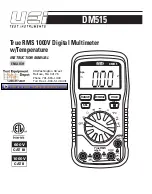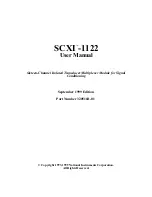
2.4
Capacity measure
1.
Set the function switch to the F position.
2.
Connect the black test lead to the (-) jack „COM” and red lead to the (+) jack „mA”.
3. Connect test leads across the capacitor under measurement and be sure that the polarity of connection is observed.
Note
:
1.
If the value of the measurable resistance over helming the value of the maximum measurable level, and if the instrument overloaded, (“-
1” or”1”) choose a higher measure range.
2.
Unit: 1uF=10
3
nF 1nF=10
3
pF
3. When checking in-circuit capacitance, be sure that the circuit has all power removed and all capacitor are fully discharged(the electrolite
capacitor shuold be discharged several times).
2.5
Diode and continuity check
1.
Connect the black test lead to the COM and the red one to the V/
Ω
/Hz/C port (Note: the polarity of the red wire is +)
2.
Turn the Function switch to
mode.
3.
Connect the leads to the outlet of the diode. Now you can see the open voltage of the diode on the display.
4. Touch two point of the circuit with the wires, a buzzer sounds when the resistance of the circuit to be measured is less than approx.70
Ω
.
Note:
1.
If you don’t connect any unit to the ports the display will show “1” or “-1”
2.
The current flowing through the diode during the test is 1 mA.
3.
The display will show the open voltage in mV or “overload” if you switched the polarities.
2.6
Measuring Temperature
1.
Set the Function switch to °C or to °F.
2.
Put the sensor of the probe into the socket (pay attention to the polarity, it should be -) and put the other to the place of which the
temperature you want to measure. On the display you will see the measured temperature in °C or °F.
9
Summary of Contents for MX-25 302
Page 1: ......






























